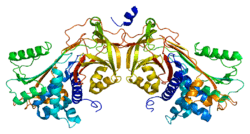Heparin cofactor II
Heparin cofactor II (HCII), a protein encoded by the SERPIND1 gene, is a coagulation factor that inhibits IIa, and is a cofactor for heparin and dermatan sulfate ("minor antithrombin").[3]
The product encoded by this gene is a serine proteinase inhibitor which rapidly inhibits thrombin in the presence of dermatan sulfate or heparin. The gene contains five exons and four introns. This protein shares homology with antithrombin III and other members of the alpha 1-antitrypsin superfamily. Mutations in this gene are associated with heparin cofactor II deficiency.[3]
Heparin Cofactor II deficiency can lead to increased thrombin generation and a hypercoagulable state.
References
Further reading
- Griffith MJ, Carraway T, White GC, Dombrose FA (1983). "Serpin receptor 1: heparin cofactor activities in a family with hereditary antithrombin III deficiency: evidence for a second heparin cofactor in human plasma.". Blood. 61 (1): 111–118.
- Pizzo SV (1989). "Serpin receptor 1: a hepatic receptor that mediates the clearance of antithrombin III-proteinase complexes.". Am. J. Med. 87 (3B): 10S–14S. doi:10.1016/0002-9343(89)80524-8. PMID 2552799.
- Uszyński M (1992). "Tissue anticoagulants in the human placenta: preliminary study with a heparin-like anticoagulant and review of the literature.". Gynecol. Obstet. Invest. 32 (3): 129–33. doi:10.1159/000293013. PMID 1836773.
- Sutherland JS, Bhakta V, Filion ML, Sheffield WP (2006). "The transferable tail: fusion of the N-terminal acidic extension of heparin cofactor II to alpha1-proteinase inhibitor M358R specifically increases the rate of thrombin inhibition.". Biochemistry. 45 (38): 11444–52. doi:10.1021/bi0609624. PMID 16981704.
- Giri TK, Tollefsen DM (2006). "Placental dermatan sulfate: isolation, anticoagulant activity, and association with heparin cofactor II.". Blood. 107 (7): 2753–8. doi:10.1182/blood-2005-09-3755. PMC 1895383
 . PMID 16339402.
. PMID 16339402.
- Liu T, Qian WJ, Gritsenko MA, et al. (2006). "Human plasma N-glycoproteome analysis by immunoaffinity subtraction, hydrazide chemistry, and mass spectrometry.". J. Proteome Res. 4 (6): 2070–80. doi:10.1021/pr0502065. PMC 1850943
 . PMID 16335952.
. PMID 16335952.
- Rual JF, Venkatesan K, Hao T, et al. (2005). "Towards a proteome-scale map of the human protein-protein interaction network.". Nature. 437 (7062): 1173–8. doi:10.1038/nature04209. PMID 16189514.
- Schillinger M, Exner M, Sabeti S, et al. (2005). "High plasma heparin cofactor II activity protects from restenosis after femoropopliteal stenting.". Thromb. Haemost. 92 (5): 1108–13. doi:10.1267/THRO04051108. PMID 15543340.
- Collins JE, Wright CL, Edwards CA, et al. (2005). "A genome annotation-driven approach to cloning the human ORFeome.". Genome Biol. 5 (10): R84. doi:10.1186/gb-2004-5-10-r84. PMC 545604
 . PMID 15461802.
. PMID 15461802.
- Suzuki Y, Yamashita R, Shirota M, et al. (2004). "Sequence comparison of human and mouse genes reveals a homologous block structure in the promoter regions.". Genome Res. 14 (9): 1711–8. doi:10.1101/gr.2435604. PMC 515316
 . PMID 15342556.
. PMID 15342556.
- Corral J, Aznar J, Gonzalez-Conejero R, et al. (2006). "Homozygous deficiency of heparin cofactor II: relevance of P17 glutamate residue in serpins, relationship with conformational diseases, and role in thrombosis.". Circulation. 110 (10): 1303–7. doi:10.1161/01.CIR.0000140763.51679.D9. PMID 15337701.
- Fortenberry YM, Whinna HC, Gentry HR, et al. (2004). "Molecular mapping of the thrombin-heparin cofactor II complex.". J. Biol. Chem. 279 (41): 43237–44. doi:10.1074/jbc.M406716200. PMID 15292227.
- Zhang F, Wu Y, Ma Q, et al. (2004). "Studies on the effect of calcium in interactions between heparin and heparin cofactor II using surface plasmon resonance.". Clin. Appl. Thromb. Hemost. 10 (3): 249–57. doi:10.1177/107602960401000307. PMID 15247982.
- Anderson NL, Polanski M, Pieper R, et al. (2004). "The human plasma proteome: a nonredundant list developed by combination of four separate sources.". Mol. Cell Proteomics. 3 (4): 311–26. doi:10.1074/mcp.M300127-MCP200. PMID 14718574.
- Strausberg RL, Feingold EA, Grouse LH, et al. (2003). "Generation and initial analysis of more than 15,000 full-length human and mouse cDNA sequences.". Proc. Natl. Acad. Sci. U.S.A. 99 (26): 16899–903. doi:10.1073/pnas.242603899. PMC 139241
 . PMID 12477932.
. PMID 12477932.
- Noda A, Wada H, Kusiya F, et al. (2003). "Plasma levels of heparin cofactor II (HCII) and thrombin-HCII complex in patients with disseminated intravascular coagulation.". Clin. Appl. Thromb. Hemost. 8 (3): 265–71. doi:10.1177/107602960200800311. PMID 12361205.
- Baglin TP, Carrell RW, Church FC, et al. (2002). "Crystal structures of native and thrombin-complexed heparin cofactor II reveal a multistep allosteric mechanism.". Proc. Natl. Acad. Sci. U.S.A. 99 (17): 11079–84. doi:10.1073/pnas.162232399. PMC 123213
 . PMID 12169660.
. PMID 12169660.
- Cunningham MA, Bhakta V, Sheffield WP (2003). "Altering heparin cofactor II at VAL439 (P6) either impairs inhibition of thrombin or confers elastase resistance.". Thromb. Haemost. 88 (1): 89–97. PMID 12152684.
- Hayakawa Y, Hirashima Y, Kurimoto M, et al. (2002). "Contribution of basic residues of the A helix of heparin cofactor II to heparin- or dermatan sulfate-mediated thrombin inhibition.". FEBS Lett. 522 (1-3): 147–50. doi:10.1016/S0014-5793(02)02930-7. PMID 12095635.
- Mitchell JW, Church FC (2002). "Aspartic acid residues 72 and 75 and tyrosine-sulfate 73 of heparin cofactor II promote intramolecular interactions during glycosaminoglycan binding and thrombin inhibition.". J. Biol. Chem. 277 (22): 19823–30. doi:10.1074/jbc.M200630200. PMID 11856753.
- Böhme C, Nimtz M, Grabenhorst E, et al. (2002). "Tyrosine sulfation and N-glycosylation of human heparin cofactor II from plasma and recombinant Chinese hamster ovary cells and their effects on heparin binding.". Eur. J. Biochem. 269 (3): 977–88. doi:10.1046/j.0014-2956.2001.02732.x. PMID 11846800.
PDB gallery |
|---|
|
| 1jmj: Crystal Structure of Native Heparin Cofactor II |
| 1jmo: Crystal Structure of the Heparin Cofactor II-S195A Thrombin Complex |
|
|
External links


 . PMID 16339402.
. PMID 16339402. . PMID 16335952.
. PMID 16335952. . PMID 15461802.
. PMID 15461802. . PMID 15342556.
. PMID 15342556. . PMID 12477932.
. PMID 12477932. . PMID 12169660.
. PMID 12169660. . PMID 11805133.
. PMID 11805133.
